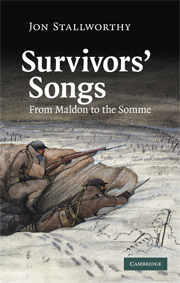Book contents
- Frontmatter
- Contents
- Voice over
- Acknowledgements
- 1 The death of the hero
- 2 Survivors' songs
- 3 England's epic?
- 4 Who was Rupert Brooke?
- 5 Christ and the soldier
- 6 Owen's afterlife
- 7 Owen and his editors
- 8 The legacy of the Somme
- 9 The iconography of the Waste Land
- 10 War and peace
- 11 The fire from heaven
- 12 Henry Reed and the Great Good Place
- 13 The fury and the mire
- Notes
- Index
5 - Christ and the soldier
Published online by Cambridge University Press: 06 July 2010
- Frontmatter
- Contents
- Voice over
- Acknowledgements
- 1 The death of the hero
- 2 Survivors' songs
- 3 England's epic?
- 4 Who was Rupert Brooke?
- 5 Christ and the soldier
- 6 Owen's afterlife
- 7 Owen and his editors
- 8 The legacy of the Somme
- 9 The iconography of the Waste Land
- 10 War and peace
- 11 The fire from heaven
- 12 Henry Reed and the Great Good Place
- 13 The fury and the mire
- Notes
- Index
Summary
Siegfried Sassoon is commonly called a ‘War Poet’ – hardly a satisfactory label at the best of times, and more than usually unsatisfactory in Sassoon's case. But if he is not simply a War Poet, what is he? Late in life, he wrote to Dame Felicitas Corrigan, the nun who had guided him into the Roman Catholic Church: ‘almost all [the critics] have ignored the fact that I am a religious poet’.
A review of the evidence for such a claim must start with biography, especially in the case of a poet whose autobiographical writings are a necessary complement to his poems. Surviving the war, Sassoon recovered quickly from his wounds, but the psychological damage war had inflicted took much longer to heal. By 1926, however, he was able to begin work on the obsessive autobiographical enterprise which was to occupy the rest of his life. The first three volumes (later collected under the title, The Complete Memoirs of George Sherston) were Memoirs of a Fox-Hunting Man (1928), Memoirs of an Infantry Officer (1930), and Sherston's Progress (1936). This trilogy was followed by two volumes covering his early life: The Old Century and Seven More Years (1938) and The Weald of Youth (1942). A final volume, Siegfried's Journey (1945), dealt with his literary activity during the Great War and after – a subject almost totally omitted from the Sherston trilogy.
- Type
- Chapter
- Information
- Survivors' SongsFrom Maldon to the Somme, pp. 55 - 67Publisher: Cambridge University PressPrint publication year: 2008



